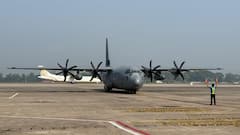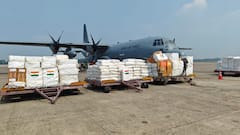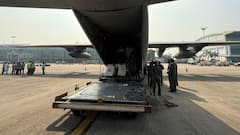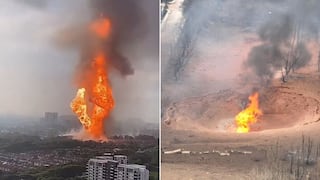5.1-Magnitude Earthquake Jolts Myanmar’s Naypyidaw A Day After Tremors Kill 1,000 People
Myanmar experienced a 5.1 magnitude earthquake near Naypyidaw on Saturday, following the devastating 7.7 and 6.4 quakes on Friday. The death toll from the initial earthquakes has risen to 1,002.

A day after powerful earthquakes devastated Myanmar, claiming over 1,000 lives, the country was struck by another tremor of magnitude 5.1 on Saturday, the United States Geological Survey (USGS) reported.
According to the USGS, the fresh seismic activity was recorded around 2:50 pm near Myanmar’s capital, Naypyidaw, at a depth of 10 kilometres. The extent of damage or casualties from Saturday’s quake remains unclear. The tremor hit as authorities were working to repair roads and restore essential services, including electricity, phone, and internet connectivity, which remained disrupted across most of the capital.
Myanmar was jolted by a powerful 7.7-magnitude earthquake on Friday, followed by a 6.4-magnitude aftershock just 11 minutes later, causing extensive destruction. The worst-hit area was Mandalay, the country’s second-largest city, home to around 1.5 million people. Buildings, bridges, historical sites, and other public infrastructure suffered severe damage.
Myanmar Death Toll Likely to Rise Further
The military-led government of Myanmar, in a statement on Saturday, confirmed that 1,002 people had been killed, 2,376 injured, and 30 others were reported missing. The statement informed that the toll could rise further as “detailed figures are still being collected,” news agency Associated Press reported.
Myanmar, which is already grappling with a prolonged civil war, is facing additional challenges in its relief operations due to the ongoing conflict. The earthquake, which struck near Mandalay, triggered landslides, caused bridges to collapse, and even burst a dam.
Tremors in Thailand, Nine Dead in Bangkok Skyscraper Collapse
The impact of the quake was also felt in neighbouring Thailand, where tremors rocked Bangkok and several provinces. In the Thai capital, a 33-storey under-construction skyscraper collapsed, leaving at least nine people dead. Rescue operations at the site entered their second day on Saturday, with 47 individuals, including Myanmar workers, still missing.
Thai authorities said the quake and aftershocks were felt across most provinces, with several northern areas, including Chiang Mai, reporting damage to homes, hospitals, and temples. However, casualties were reported only in Bangkok.
Naruemol Thonglek, 45, who was awaiting news about her partner and five friends working at the collapsed site, said, “I was praying that they had survived, but when I got here and saw the ruin—where could they be? In which corner? Are they still alive? I am still praying that all six are alive.”
Waenphet Panta, another anxious relative, said she last spoke to her daughter Kanlayanee an hour before the earthquake struck. “I am praying my daughter is safe, that she has survived and that she’s at the hospital,” she said, as quoted by AP.
Myanmar’s Vulnerability to Earthquakes
Myanmar sits on the Sagaing Fault, a major north-south fault that separates the India Plate from the Sunda Plate. Seismologist Brian Baptie from the British Geological Survey noted that the quake resulted from a 200-kilometre rupture along the fault, with a slip of up to 5 metres in some places. “When you have a large earthquake in an area where there are over a million people, many of them living in vulnerable buildings, the consequences can often be disastrous,” Baptie said, as per AP's report.
Myanmar’s Civil War Complicates Relief Efforts
Myanmar’s civil war has severely impacted relief operations, as large areas remain inaccessible due to conflict. Min Aung Hlaing, the head of the military-led government, acknowledged the dire need for blood donations in the worst-hit areas and stated that Myanmar was open to receiving foreign assistance.
Despite the devastation, military operations continued, with three airstrikes reported in northern Kayin (Karenni) state and southern Shan state—both bordering Mandalay. Dave Eubank, a former US Special Forces soldier and founder of the Free Burma Rangers, a humanitarian aid group, told the Associated Press that villages in these areas had already been destroyed by military attacks, minimising the earthquake’s direct impact.
“In the jungle where we were, the earthquake was powerful, but the trees just moved. The Burma army, however, keeps attacking, even after the quake,” Eubank said.
According to the United Nations, more than 3 million people have been displaced due to the ongoing civil war, and nearly 20 million are in urgent need of humanitarian aid. As per AP, Haider Yaqub, Myanmar country director for Plan International, said, “Although a full picture of the damage is still emerging, most of us have never seen such destruction. Without a doubt, the humanitarian needs will be significant.”
India, under ‘Operation Brahma’, sent 15 tonnes of relief materials and deployed an 80-member National Disaster Response Force (NDRF) team for rescue operations. Malaysia announced it would send a 50-member contingent on Sunday.
China and Russia, Myanmar’s largest arms suppliers, were among the first to send humanitarian aid. China dispatched over 135 rescue personnel, medical kits, and generators, pledging $13.8 million in emergency relief. Russia’s Emergencies Ministry sent 120 rescuers along with supplies.
South Korea pledged $2 million in humanitarian aid through international organisations, while the United Nations allocated $5 million for immediate relief efforts.
Meanwhile, US President Donald Trump stated on Friday that the United States would provide assistance. However, some experts expressed concerns over the scale of support, given his administration’s cuts in foreign aid.
Trending News
Top Headlines










































